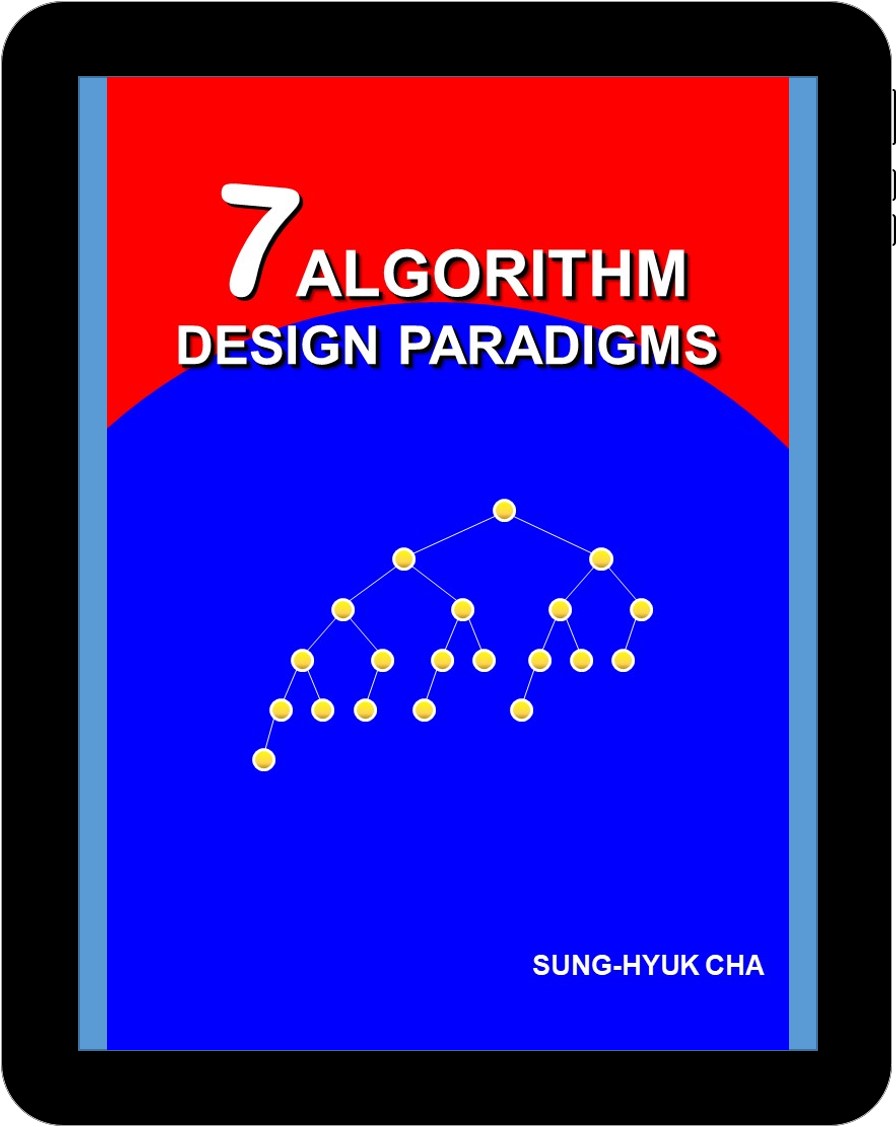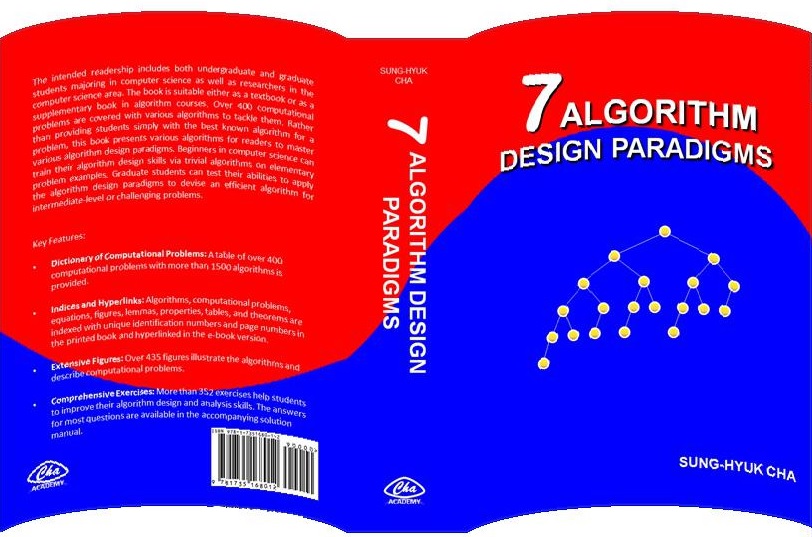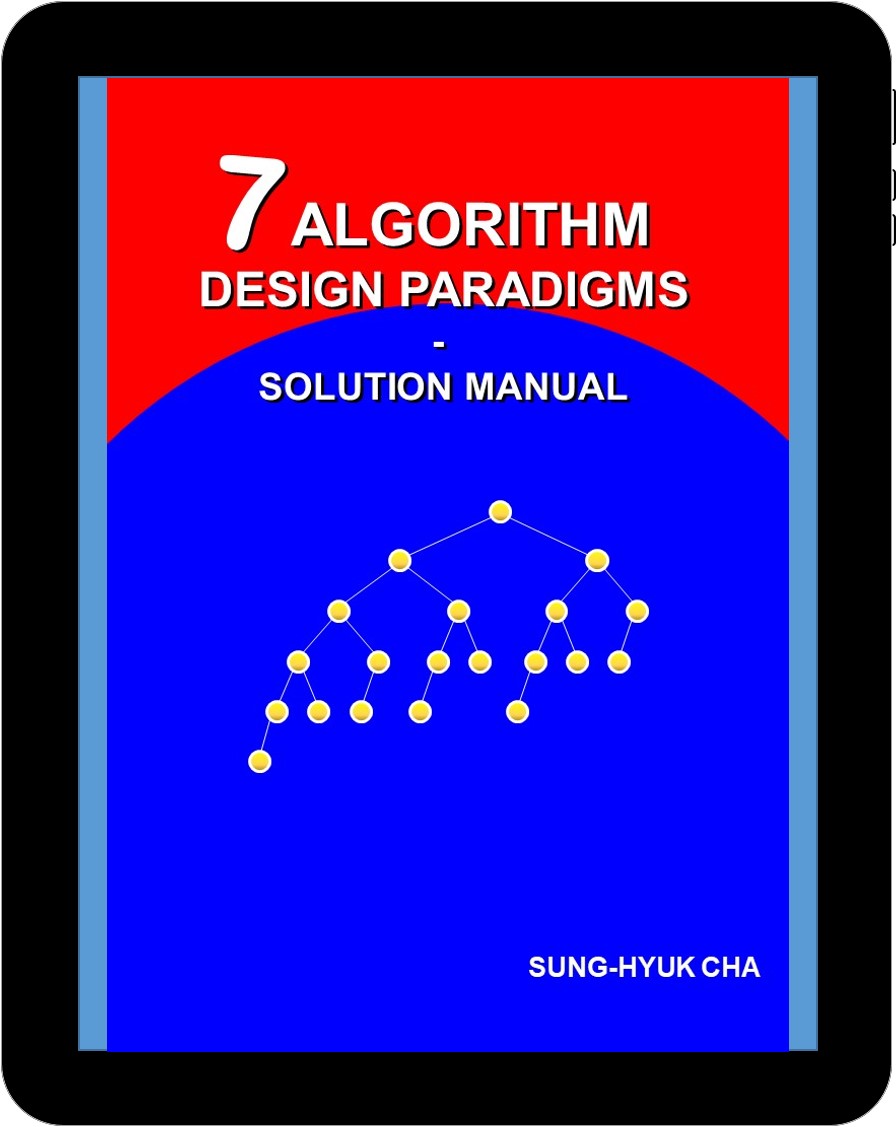7 Algorithm Design Paradigms
2020 by Sung-Hyuk Chaavailable in (Click here for GoogleBooks Preview)

Ebook (PDF) ISBN 978-1-7351680-0-5 available at |

Softcover ISBN 978-1-7351680-4-3 available at |

Hardcover ISBN 978-1-7351680-1-2 available at |
Solution Manual is also available in (Click here for GoogleBooks Preview)

Ebook (PDF) ISBN 978-1-7351680-2-9 available at |

Softcover ISBN 978-1-7351680-3-6 available at |
Description
| The intended readership includes both undergraduate and graduate students majoring in computer science as well as researchers in the computer science area. The book is suitable either as a textbook or as a supplementary book in algorithm courses. Over 400 computational problems are covered with various algorithms to tackle them. Rather than providing students simply with the best known algorithm for a problem, this book presents various algorithms for readers to master various algorithm design paradigms. Beginners in computer science can train their algorithm design skills via trivial algorithms on elementary problem examples. Graduate students can test their abilities to apply the algorithm design paradigms to devise an efficient algorithm for intermediate-level or challenging problems. |
Key Features
|
Errata on 7 Algorithm Design Paradigms
| Date | Contributor | Page | Identifier | Comment | Author's response |
|---|---|---|---|---|---|
| 8/2/2023 | Nuvorish Paul | 20 | Algorithm 1.10 line 3 | Infinite while loop | While Flag = F & i <= n |
| 5/31/2020 | Prof. Teryn Cha | 96 | Algorithm 3.4 | line 2 should be "while i <= n_1 and j <= n_2" | Thank you |
| 8/2/2023 | Nuvorish Paul | 101 | Algorithm 3.7 line 7 | The search is repeated. | Only "o = search(b, m-1)" |
| 5/28/2020 | Prof. Teryn Cha | 156 | line 12 | Citation problem [?]. | It should be [139]. |
| 7/19/2020 | Param Puneet Kaur Thind | 186 | line 4 from bottom | It does not match with Figure 4.29. | path(v2,v6) = <v2,v3,v6>, <v2,v3,v4,v6>, <v2,v4,v6>' should be 'path(v2,v7) = <v2,v4,v7>, <v2,v4,v5,v7>, <v2,v5,v7>' |
| 7/19/2020 | Param Puneet Kaur Thind | 187 | line 3 | It does not match with Figure 4.29. | pc(<v2,v3,v4,v6>) = w(v2,v3) + w(v3,v4) + w(v4,v6)' should be 'pc(<v2,v4,v5,v7>) = w(v2,v4) + w(v4,v5) + w(v5,v7)' |
| 7/19/2020 | Param Puneet Kaur Thind | 187 | line 3 from bottom | Dikstra' should be 'Dijkstra' | Thank you. |
| 7/19/2020 | Vaibhav Kumar Katturu | 217 | Algorithm 5.1 | Incorrect algorithm | 'and j divides i' is missing in line 7. |
| 10/11/2022 | Refferty Leung | 218 | Theorem 5.3 line 5 in the proof(a) | '16 < k-2' should be '16 <= k-2' | Thank you. |
| 7/19/2020 | Vaibhav Kumar Katturu | 218 | Figure 5.3 (a) | 'x(27) = x(24) = 3' shoud be 'y(27) = y(24) = 3' | Thank you. |
| 7/19/2020 | Param Puneet Kaur Thind | 221 | Algorithm 5.3 | Incorrect algorithm | line 5: 'i - a_j > 0' should be 'i - a_j >= 0' |
| 11/27/2022 | Prof. Teryn Cha | 314 | Problem 6.7 eqn(6.14) | "+1"'s are missing for insertion and deletion. | Thank you. click here for the correct answer. |
| 12/10/2023 | Ray Jennings | 315 | Figure 6.13 | Table cell value errors: From "T(6,6) = 4, T(7,7) = 5, and T(8,8) = 6" to "T(6,6) = 3, T(7,7) = 4, and T(8,8) = 5" | Thank you. click here for the correct answer. |
| 9/4/2020 | Param Puneet Kaur Thind | 363 | Line 3 | The string <11> is not acceptable, but <10> is possible. | Thank you. |
| 9/4/2020 | Vaibhav Kumar Katturu | 366 | Figure 7.11 | The node r should be rectangle rather than circle. click here. | Thank you. |
| 9/4/2020 | Param Puneet Kaur Thind | 370 | Algorithm 7.12 | negation symbol case is missing. | Thank you. A new version with negation case will be added here soon. |
| 9/4/2020 | Param Puneet Kaur Thind | 373 | Algorithm 7.16 | line 6: indentation not required. | Thank you. |
| 9/4/2020 | Param Puneet Kaur Thind | 380 | Figure 7.19 | The popped item in 4th Figure is v3 not v6. click here. | Thank you. |
| 9/4/2020 | Param Puneet Kaur Thind | 380 | Figure 7.19 | The popped item in 4th Figure is v3 not v6. click here. | Thank you. |
| 9/4/2020 | Param Puneet Kaur Thind | 389 | Figure 7.19 | Switch v5 and v6. click here. | Thank you. |
| 9/4/2020 | Vaibhav Kumar Katturu | 398 | Algorithm 7.33 | Line 6 the function name, KIB2 should be KB2. | Thank you. |
| 6/26/2020 | Prof. Soon Ae Chun | 714 | Bibliographic footnote | Ulam's bio has some phrases being repeated. | Thank you. |
| 5/17/2020 | Prof. Teryn Cha | 744 | line 2 | Problem title should match with Eqn (8.4). | Thank you. |
Errata on 7 Algorithm Design Paradigms - Solution Manual
| Date | Contributor | Page | Identifier | Comment | Author's response |
|---|---|---|---|---|---|
| 9/2/2020 | Mun Jeong Lee | S-8 | Q 1.9 d) | "Base case h = 1" should be h = 0 | Thank you. |
| 2/16/2022 | Boyi Zhang | S-54 | Q 3.2 g) | c =3/2 violates c > 1 condition | "c = 3/2" should be "c = 1.5/2" |
| 2/23/2022 | Abdimanapov, Bekzhan | S-102 | Algorithm S-4.11. | 'wi' should be 'qi'. | Thank you. |
| 2/23/2022 | Liu, Kelly | S-103 | Problem S-4.9. | '<= m' should be '>= m'. | Thank you. |
| 9/23/2020 | Mun Jeong Lee | S-104 | Q 4.13 c) | "Crab column should have amt. = 150g and fat = 13. | Thank you. |
| 8/2/2023 | Nuvorish Paul | S-110 | Algorithm S-4.18 line 8 | Invalid variable m(should be n). | Thank you. |
| 3/1/2022 | Houqi Zhan | S-159 | Q 5.19 a) Algorithm S-5.16 | line 4 should be "L(i) = L(floor((i-1)/2)+L(ceil((i-1)/2)+ floor(log i) +1" | Thank you |
| 5/21/2021 | Prof. Teryn Cha | S-193 | Q 5.30 e) Algorithm S-5.42 | line 6 should be "L[i] = 2 L[i-1] - L[i-k-1]" | Thank you |
| 5/21/2021 | Prof. Teryn Cha | S-193 | Q 5.30 h) eqn (S-5.68) | line 4 should be "T[n] = 2KBF2(n-1, k) - KBF2(n-k-1, k)" | Thank you |
| 8/2/2023 | Nuvorish Paul | S-198 | Algorithm S-5.46 line 3 | Table LT is already initialised as 0's. | Either remove it or initialize LT with nil. |
| 11/27/2022 | Prof. Teryn Cha | S-234 | Q 6.15 d) | click here for the correct answer. | Thank you. |
| 11/27/2022 | Prof. Teryn Cha | S-236 | Q 6.16 d) | click here for the correct answer. | The original one is also a possible answer but the provided one matches with the table in c). Thank you. |
| 5/1/2022 | Liu, Kelly | S-264 | Q 7.1 b) | click here for the correct answer. | Thank you. |
| 5/1/2022 | Liu, Kelly | S-266 | Q 7.2 b) | click here for the correct answer. | Thank you. |
| 8/2/2023 | Nuvorish Paul | S-302 | Algorithm S-7.41 line 1 | Illustration in b) is - inf while it states 0. | Change line 1 to initially - inf from 0. |
| 4/10/2022 | Liu, Kelly | S-375 | Q 9.7 a) | The second tree in the second row. The node 20 should be 12. | Thank you |
| 4/6/2022 | Liu, Kelly | S-377 | Q 9.8 e) | min_k(A_{1~i}) column has wrong answers. | They should be the same as the first element in the array or the root node. |
| 4/10/2022 | Liu, Kelly | S-411 | Q 10.2 f) | The toy example does not match. | Change "A = <2.0, 0.5, 4.0" to "A = <2.0, 0.5, 5.0" |
| 4/10/2022 | Liu, Kelly | S-412 | Algorihtm S10.7 | Method name should be 'SKSSmin' and line 3 should 'SKSPmin'. | Thank you |
| 10/28/2020 | Mun Jeong Lee | S-417 | Algorithm S-10.21 | does not match with Figure S-10.1. | line 5 should be o_{3i-1} = a'_{r + \floor{n/3} + i} line 6 should be o_{3i} = a'_{r + 2\floor{n/3} + i} |
| 11/4/2020 | Mun Jeong Lee | S-497 | eqn S-11.3 | Wrong equation. | Oplus symbol should be biconditional symbol. O = CEU_algox should be removed as well. |
| 4/27/2022 | Liu, Kelly | S-547 | Q 12.13 b) | The pivot is 17 in the odd length case: A. click here for the correct answer. | Thank you. |
| 4/27/2022 | Liu, Kelly | S-548 | Algorithm S-127 | "quick_updown" should be "quick_downup" in lines 12 and 15. | Thank you. |
| 4/27/2022 | Liu, Kelly | S-549 | Q 12.14 c) | 10 is not in the list. | Change the pivot to be 17. After partitioning, <15, 12, 2, 1, 17, 35, 80, 30, 20> and after the interweaving, it should be <17, 15, 35, 12, 80, 2, 30, 1, 17>. |
| 4/27/2022 | Liu, Kelly | S-549 | Q 12.14 e) | 10 is not in the list. | Change the pivot to be 15. After partitioning, <1, 12, 2, 15, 20, 35, 17, 30, 80> and after the interweaving, it should be <20, 1, 35, 12, 17, 2, 30, 15, 80>. |